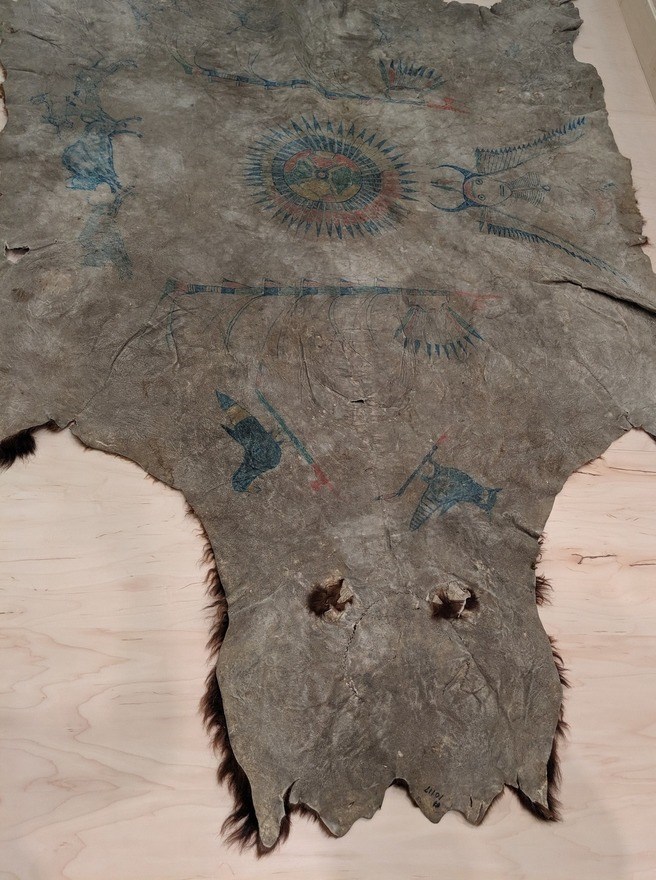The MacKenzie Art Gallery (MAG) is pleased to present The Permanent Collection: Walking with Saskatchewan. Curated by Bruce Hugh Russell, Walking with Saskatchewan is our inaugural exhibition from the Permanent Collection series of year-long exhibitions that will explore the depth of our collection and the University of Regina collection, with select loans from other institutions. One of these loans, courtesy of the North Dakota State Historical Society, is Sitting Bull’s robe, which returns to Saskatchewan after at least 75 years away. We will be commemorating the opening of Walking with Saskatchewan, and the occasion of hosting Sitting Bull’s robe, with an event on June 20 at 7 PM. In honour of Indigenous People’s Day, Lakota artist and Knowledge Keeper Wayne Goodwill, a member of Standing Buffalo First Nation, will share stories in relation to his and Sitting Bull’s art.
Sitting Bull's robe, on loan to the MacKenzie Art Gallery, is the only buffalo robe known to have been painted by legendary Hunkpapa chief and artist, Sitting Bull (one other robe was painted by Sitting Bull that was gifted to the Vatican, but it has since been reportedly lost). The robe was painted between 1877 and 1881 while Sitting Bull was in the territory now known as Saskatchewan, seeking asylum. The image on the robe features a presumed self portrait of Sitting Bull wearing his strong heart bonnet below a feathered sun that is flanked by two pipes on either side. While Sitting Bull was in Canada he traded with Gus Hedderich at Woody Mountain, and the Buffalo Robe was given to Hedderich by Sitting Bull a few years later. After Hedderich and his wife passed away, the robe was donated to the State Historical Society of North Dakota by M.C. Seekatz in 1945. This will be its first public display in Canada and we invite the Lakota people and decedents of Sitting Bull to welcome this work back for its ten-month return to this territory.
“We have heard from visitors and the community the desire to have our permanent collection on display for long periods of time,” says Anthony Kiendl, CEO and Executive Director of the MacKenzie Art Gallery. “As stewards of over 5,000 pieces of art, representing 5,000 years of culture, we wanted the focus of this permanent collection exhibition to speak to this province, and this land’s history, from settler and Indigenous perspectives over the last 150 years.”
“Saskatchewan” comes from the Cree word kiskiskâciwan (or kisiskatchewani sipi), which describes a river that flows at a walking pace. Referencing both this Cree origin and its anglicization, Walking with Saskatchewan examines how Indigenous and non-Indigenous peoples represent and relate to this land as we walk it together.
“I am honoured to have been asked to do the first in this series of permanent collection exhibitions for the MacKenzie Art Gallery,” says guest curator for Walking With Saskatchewan, Bruce Hugh Russell. “It is humbling to know that this is the first in a long line of permanent collection exhibitions that will follow over the years, and other curators will be asked to create new shows around these works. I wanted this first exhibition to speak to this land, and the people that have called it home for centuries.” Russell added, “one of my goals was to identify gaps in the collection’s ability to survey Saskatchewan rich art history. I am especially pleased that approximately 15% of the works in the exhibition are new acquisitions or promised gifts that will be acquired as a result of this process.”
The MAG has created a distinct visual identity for works and projects related to The Permanent Collection, which incorporates pictograms designed by Urbankink’s Marcelle Lussier with Sébastien Aubin. These pictograms come from unattributed words spoken by Indigenous peoples of Turtle Island to articulate the spirit of our treaties: “as long as the sun shines, the grass grows, and the river flows.” These words (which also grace the exterior of our building in Duane Linklater’s LED text work Kâkikê / Forever) suggest that Indigenous and non-Indigenous peoples will harmoniously share this land with care and respect in perpetuity. As we build and care for a collection that is meant to provide a permanent home for our cultural objects and histories, we include these symbols as a reminder to ourselves of our responsibility to live the commitment of these treaties, while respecting all that cannot be contained within our walls.
“The MacKenzie Art Gallery’s permanent collection has always had a focus on both Indigenous and non-Indigenous art, and has a long history of Indigenous and non-Indigenous curators working side-by-side to build and guide this collection,” says John Hampton, Director of Programs. “We are continually thinking through how we can act as effective and ethical caretakers for the cultural histories of this land, and the spirits of the treaties provide a deeply meaningful and productive framework for articulating our responsibilities as we care for these vital histories. We hope this exhibition, and the larger Permanent Collection series, starts to communicate the vast, complex, tragic, and beautiful histories of this shared territory.”
This exhibition is on view until April 2020.
The MacKenzie Art Gallery is grateful for the support of South Saskatchewan Community Foundation, Canada Council for the Arts, SaskCulture, City of Regina, University of Regina, and Saskatchewan Arts Board.



